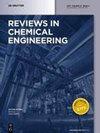Modification of advanced low-dimensional nanomaterials towards high performance CO2 adsorption: an interpretative state-of-the-art review
IF 6.6
3区 工程技术
Q1 ENGINEERING, CHEMICAL
引用次数: 0
Abstract
Carbon capture continues to gain attention from researchers especially in light of alarming increase of greenhouse gases in the atmosphere in the recent decades. Among the available carbon capture technologies, both of physical and chemical adsorption is favourably seen with various applicable adsorbents successfully introduced. Such promising CO先进的低维纳米材料对高性能二氧化碳吸附的改性:一种解释性的最新研究综述
碳捕获继续受到研究人员的关注,特别是考虑到近几十年来大气中温室气体的惊人增长。在现有的碳捕获技术中,物理吸附和化学吸附都很受欢迎,并成功介绍了各种适用的吸附剂。这些有前途的二氧化碳吸附剂候选者包括低维纳米材料,如石墨烯、碳纳米管(CNTs)和相当新的MXenes。在这篇综述中,我们将介绍这些材料的各种改性和功能化对提高二氧化碳吸附能力的影响。这包括含氧官能团和质子官能团的官能团化、杂原子掺杂、缺陷工程和表面修饰。石墨烯的掺杂、碳纳米管的胺功能化和MXenes的表面终止修饰是目前研究最广泛的几种策略。由于MXenes是二氧化碳捕获领域的新成员,我们还介绍了一些基本的理论发现,向读者介绍这种新的二维纳米材料。通过本文的综述,我们旨在更好地了解改性和功能化过程如何有助于提高CO2吸附剂的吸收,以帮助未来合成高性能吸附剂。
本文章由计算机程序翻译,如有差异,请以英文原文为准。
求助全文
约1分钟内获得全文
求助全文
来源期刊

Reviews in Chemical Engineering
工程技术-工程:化工
CiteScore
12.30
自引率
0.00%
发文量
37
审稿时长
6 months
期刊介绍:
Reviews in Chemical Engineering publishes authoritative review articles on all aspects of the broad field of chemical engineering and applied chemistry. Its aim is to develop new insights and understanding and to promote interest and research activity in chemical engineering, as well as the application of new developments in these areas. The bimonthly journal publishes peer-reviewed articles by leading chemical engineers, applied scientists and mathematicians. The broad interest today in solutions through chemistry to some of the world’s most challenging problems ensures that Reviews in Chemical Engineering will play a significant role in the growth of the field as a whole.
 求助内容:
求助内容: 应助结果提醒方式:
应助结果提醒方式:


